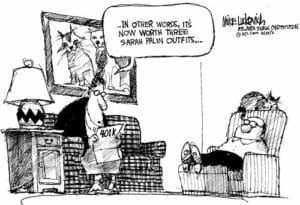Retirees Wake Up to a Swindle
The essential fallacy of the 401(k) has been exposed. It took a historic market collapse -- one that threatens to impoverish workers already in retirement and those who are nearing it.The essential fallacy of the 401(k) has been exposed.
It took a historic market collapse — one that threatens to impoverish workers already in retirement and those who are nearing it. But then, crushing hardship is often what’s required to usher out an era of ideological illogic and unconscionable greed.
The advent of the 401(k) in the late 1970s and early 1980s was a leading indicator of what became a political mania for shifting the risk and responsibility for life’s big challenges — health care, an adequate income in retirement — from employers and other broad-shouldered institutions to the narrower, weaker backs of individuals themselves.
It was never sold this way, of course. The pitch for the 401(k) was a contemporary version of the get-rich-quick scheme: The promise of strolling along a sun-dappled beach in retirement would be realized with ease, so long as workers regularly contributed modest amounts to the accounts, then let the compounding magic of the market work. To hear the mutual fund companies and the media tell it, only fuddy-duddies and dinosaur employers would be foolish enough to opt for the old-fashioned defined-benefit pension, the type employers paid for and professional managers oversaw, and which guaranteed monthly payments in old age. The type that gave the hard-boiled men and women of the industrial age security, but would never reward them with riches.
The offer seemed good to media observers, and to the politicians who nurtured the do-it-yourself retirement with successive legislative schemes. During the stock market boom of the 1990s, esteemed business publications published breathless articles featuring manufacturing workers who would use their lunch breaks to track their mutual fund balances and ponder the possibilities of the loan they would take out for a cabin on the lake or an anniversary trip to Hawaii.
But despite the hype, the data on 401(k)s have never — ever — shown that these accounts were creating a mass of workers who would be able to retire with security, let alone luxury.
The 401(k)s didn’t expand the proportion of the work force with pension coverage, notwithstanding claims that shifting to accounts that required workers to contribute would make employers more willing to offer the benefit. Less than half of workers have any type of pension coverage from their current employer at all, according to the Center for Retirement Research at Boston College.
For those who do have retirement accounts, the bottom line has long been grim. In 2004, the last year for which data are available, the median balance in IRA and 401(k) retirement accounts was $35,000, according to the Federal Reserve. For those nearest to retirement — households headed by someone between 55 and 64 — the median balance in 2004 was $60,000. That’s enough to generate about $400 a month in retirement income, according to the research center.
These numbers reflect balances before the current market meltdown, which wiped out about $2 trillion in retirement assets when losses in individual accounts as well as employer-based pension funds are tallied.
How did this happen? Like so many other political experiments of the last three decades, it was good for the corporate bottom line — and therefore, supposedly good for America. The 401(k) plan was first promoted to supplement, not replace, traditional pensions, according to Alicia Munnell, director of the Boston College center. Over time, as new businesses were formed, they opted to provide only these accounts, eschewing traditional plans.
More recently, even companies with healthy, traditional pension systems have frozen those plans (effectively abandoning their pledges to longtime workers) and replaced them with 401(k)s. Why? “Shifting from a defined-benefit plan to a 401(k) plan will reduce required employer contributions from 7 to 8 percent of payrolls to the 3 percent employer match,” Munnell and a team of researchers wrote in a 2006 paper.
This was never about empowering workers to reap the rewards of financing their own retirement. It was about reducing corporate costs.
“I think what has become clear is that we just can’t have a system where people are exposed to this type of market risk,” Munnell told me in an interview. Nor, in the age of global competition, can American businesses solely shoulder pension costs that in other countries are at least partially borne by governments.
Some new system that might be called “Social Security-plus” must be developed. Remember that in a year or two, when politicians try to sell us on the supposed need to “reform” Social Security with something that really amounts to Social Security-minus.
Marie Cocco’s e-mail address is mariecocco(at)washpost.com.
© 2008, Washington Post Writers Group
Your support matters…Independent journalism is under threat and overshadowed by heavily funded mainstream media.
You can help level the playing field. Become a member.
Your tax-deductible contribution keeps us digging beneath the headlines to give you thought-provoking, investigative reporting and analysis that unearths what's really happening- without compromise.
Give today to support our courageous, independent journalists.




You need to be a supporter to comment.
There are currently no responses to this article.
Be the first to respond.